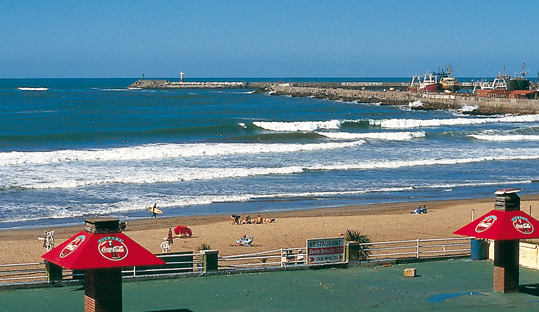Stormrider Guide to surfing Mar del Plata
Argentina, SOUTH AMERICA
|
 Playa Grande, Javier Amezaga
Playa Grande, Javier Amezaga
|
Summary
|
+ Spot concentration
|
- Crowded urban spots
|
|
+ Break diversity
|
- Summer surfing bans
|
|
+ Many wind and swell options
|
- Freezing winters
|
|
+ Wide range of accommodation
|
- Built up and polluted
|
|
|
Second largest country on the South American continent, Argentina counts around 300km (186mi) of surfable beaches, most of them located in Buenos Aires Province. The east side of the country called Pampas, consists mainly of grassy plains while the country's western regions climb into the vertiginous Andes. Argentina recently celebrated 40 years of surfing at a variety of breaks ranging from natural pointbreaks to man-made jetties. Mar del Plata stands as the main summer getaway for "Porteños" escaping their Buenos Aires lives. The city beaches stretch over 8km (5mi), but dozens of piers and jetties bisect the coastline into many surf spots.
When to Go
Most of the swell comes from Roaring Forties wintertime depressions that send 3-12ft (1-4m) of swell before tracking east towards Africa. In the summer, constant NE winds will send smaller and inconsistent windswells between November and February. Summer dominant NE winds typically blow offshore in the morning before shifting onshore between 12-5pm. NW winds dominate in autumn before SE takes over in September/October. The indented shape of the coast and the numerous jetties help shelter from strong winds, but as a rule the best sessions occur when the winds go back to blowing offshore after the howling SE’er that sent the swell. Tides should be watched closely as they can make quite a difference on certain breaks.
Surf Spots
Statistics |
J
|
F
|
M
|
A
|
M
|
J
|
J
|
A
|
S
|
O
|
N
|
D
|
| dominant swell |
NE -S |
NE -S |
E -S |
E -S |
E -S |
NE -S |
| swell size (ft) |
2-3 |
3 |
4 |
4-5 |
4 |
2-3 |
| consistency (%) |
50 |
60 |
70 |
75 |
70 |
60 |
| dominant wind |
N -NE |
NW -NE |
NW -N |
NW -N |
NW -NE |
NW -NE |
| average force |
F4 |
F3-F4 |
F4 |
F4 |
F4 |
F4 |
| consistency (%) |
38 |
43 |
50 |
58 |
56 |
48 |
| water temp (C) |
20 |
18 |
13 |
10 |
11 |
16 |
| wetsuit |
3/2 |
3/2 |
4/3 |
5/4 |
5/4 |
3/2 |
|
Travel Information
Weather
Stretching as far north as the Tropic of Capricorn all the way to the Cape Horn, Argentina knows a wide diversity of climate. The coastal central area is relatively humid with great variations in temperatures. The winter is dry and cold with temperatures remaining between 5-13°C (41-56°F) in July/August. It's possible to go snowboarding between July and September. Rainfalls are more pronounced in the east of the country than in the west and shallow summer flooding is not uncommon in the flat Pampas areas. The bay of Miramar enjoys a great climate, as it seems to receive fewer storms than MDP. The water gets real cold in the peak wave season. Between June and August a 5/4/3 fullsuit complete with booties, gloves and hood is what it takes to avoid freezing in 9°C (48°F) waters. 3/2 fullsuits are good between seasons before summer (December/February) allows springsuits and maybe even quick dips wearing only trunks.
|
Lodging and Food
Among 700 lodging options in MDP, Hotel Electra ($15/p), Hostería San Valentín ($25/dble) and Hotel Traful ($75/dble) are all close to the central beaches and La Pepita. The classier Gran Hotel Iruña has rooms with views to the beaches next to La Popular for $120/dble. Argentina's beef is the best in the world.
|
Nature and Culture
MDP in summer is as packed as a city can be and everything revolves around hanging-out at the beach, bar-hopping around Plaza Mitre and dancing the rest of the night. Hang out around the port or visit the Museo del Mar, which displays over 30,000 shells. Juan Manuel Fangio has his own museum in Balcarce.
|
|
